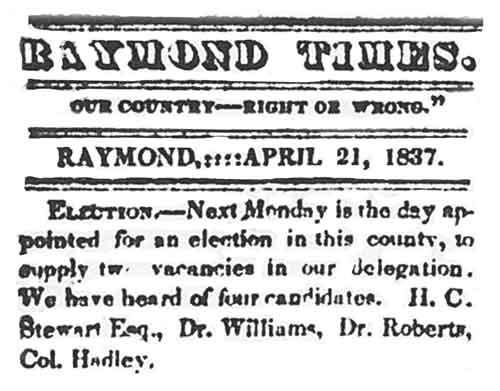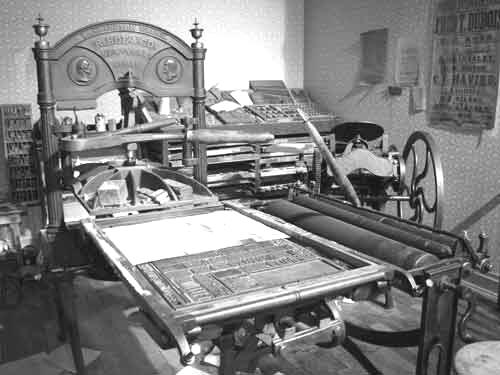"Raymond Years Ago"
By George W. Harper
Journalist - Editor - Owner Of Hinds County Gazette 1845-1883
A Series Published in the Hinds County Gazette, 1878-1879
From the Gillespie Collections edited by Pattie Adams Snowball and Rebecca Blackwell Drake
Home Page
Harper Arrives in Mississippi
Vicksburg & Meridian RR
Businesses in 1844
The Raymond Bar
Early Merchants
1844 Businesses
Seat of Justice
Cotton Industry
Early Churches
Establishment of Schools
John B. Peyton
Raymond Area Homes
Medicinal Resorts & Spas
The Mexican War
Early Churches
Early Schools
Raymond Female Institute
Raymond Military Institute
McNutt-Foote Debate
1844 Presidential Election
Local Elections of 1845
Literary Raymond
Raymond Fires
Old Log Jail
Death of Jos. Stewart
Murder of Benj. Sims
Duel Ends in Death
Raymond & Bolton RR
Harper Elected Mayor
Chaos at Oak Tree Hotel
Great Fire of 1858
Early Area Settlements
-
Amsterdam
-
Yeizer's Store
-
Newtown
-
Meridian Springs
-
Sturgiss Store
-
Dry Grove
-
County Line
Rev. Fisk's Biology Class
Fisk Charged with Fraud
Fleetwood Tragedy
Local Racetracks
Dignitaries Visit Raymond
Winning the Lottery
Fire Company No. 1
"Devoted & Valued Friend"
Tribute to Amos Johnson
Yellow Fever Strikes Raymond
Doctors Treating Victims
Cooper's Well
Mississippi Springs
Newspaper Entrepreneurs
Yankees Sack Gazette Office
Fate of Editorial Giants
Henry Clay Defeated in 1844
Stray Cats in Raymond
"A Remarkable Occurrence"
Blow That Punky Bell to Hell"
Isom Bldgs Destroyed
1851 Gubernatorial Election
Union Ticket Sweeps State
New Raymond Courthouse
Gibbs Building Rebuilt
Hinds Co. Poor House
Schools Struggle
Murder of Addie Owens
War comes to Raymond
The Battle of Raymond
Willie Foote Captured
Make-shift Hospitals
Yankees Occupy Raymond
Raymond Lodge No. 21
Odd-Fellows' Graveyard
Bolls Incarceration
Crimes Blamed on Whisky
Peyton's Willow Tree Prank
Politics in Raymond
Presidential Election 1860
Hinds Co. for Succession
Raymond Fencibles Organized
Churches Reorganize
The Clinton Riot of 1875
Why the Great Uneasiness?
Deaths of Sivley & Thomson
"Kill the Raymond Men"
Harrison Election
Political Gatherings
Event at Dupree's Grove
Presidential Election 1876
Governor Ames Impeached
Great Wrongs Investigated
Fight the Devil with Fire
Reconstruction Era
Harper Ends with Poetic Vision
Part XIII
Town of Newspaper Entrepreneurs
With the velocity of lightning, after the first house was built in Raymond, came the Printing Press – the great civilizer and christianizer of the 19th century. It was about the year 1830, just 49 years ago, that Samuel T. King, (whose widow still resides here, in the same house she occupied with her now deceased husband when we came in 1844) removed to Raymond from Woodville, this State, bring with him a printing office. He was assisted in his enterprise, we think, by Franklin E. Plummer, who was a candidate for Congress, and one of the rising men of the State. The first newspaper was called The Public Echo, and was issued by Mr. King, as he supposed, under most favorable circumstances. The town was building up rapidly, and the tide of immigration into this part of the county was assuming large proportions. But after a fair trial, the Echo proved anything but a remunerative institution, and after an existence of a year or two, suspender, and soon Mr. King removed from the town and county, residing for a time, we believe, at Brandon. Mr. King being a Jackson man at that time, as was also Mr. Plummer, of course the Echo was a Jackson paper.
About a year after the demise of the Echo, Mr. King came back to Raymond, and from the same office issued another paper, which he called The People’s Advocate. But the Advocate, also like its predecessor, died while young, and the entire establishment was soon moved to another locality, The Advocate was Democratic in politics.
In 1836 Mr. King, undismayed by previous failures, brought
another office to Raymond, and at once issued The Raymond Times, from which
period Raymond has never been without a newspaper. The Times was a Whig paper,
and was under the editorial control of D. C. Briggs and A. L. Dabney. It was a
success for three or four years. In 1839 N. G. North became associated with Mr.
King as joint publisher, and also assumed charge of the editorial department. In
1842, however, it suspended, giving way to another publication, which will be
noticed in its order.

In 1840 a gentleman by the name of Martin, who had been a merchant of the town for some time, and had failed, desired to show how easy it was to publish a good paper in Raymond, and brought to the town, from Natchez, (under the patronage, no doubt, of eminent men of the Democratic party,) the most expensive printing office for a village that we ever saw. They issued the Comet, with John Jenkins and J. J. Davenport, two lawyers of the town, as editors. The great presidential contest between Harrison and Van Buren was then at its height and the Comet was strongly for Van Buren, and at once assumed a leading position among the newspapers of the State. But, pecuniary embarrassment overtook it at an early day, and months before the election it gave up the ghost. The material was purchased by King & North, of the Times, and was the same that was lost as Hinds County Gazette property in the great fire of 1858.
The Harrison Club of Raymond, in the summer of 1840, established a campaign paper, called The Snag Boat. It was printed at the Times office, by contract, and was regarded at the time as one of the ablest and most efficient papers in the Whig cause in the south-west. It was conducted by a committee appointed by the Club, consisting of A. R. Johnston, Thos. S. Dabney. D. C. Briggs, and others. It was a splendid paper, and secured a large circulation, extending throughout three or four States. It lived through the canvass, of course, and accomplished its purpose of carrying Hinds county and the State of Mississippi overwhelmingly for Harrison and Tyler.
 In 1842 King & North discontinued the publication of the
Times, establishing on its ruins The South–Western Farmer, a journal devoted
almost exclusively to the agricultural and mechanical interests of the cotton
growing region: with John Jenkins and N. G. North, editors.
In 1842 King & North discontinued the publication of the
Times, establishing on its ruins The South–Western Farmer, a journal devoted
almost exclusively to the agricultural and mechanical interests of the cotton
growing region: with John Jenkins and N. G. North, editors.
In 1844 the Farmer was changed from a folio to a quarto, much enlarged, brought out in new type, and under the following management: M. W. Philips and N. G. North, editors: Geo. W. Harper, office editor; and King & Harper, publishers. The paper, under the new arrangement, gave promise of great success. It was, we think, the best printed and most ably conducted agricultural paper ever published in the State. The farmers took a great interest in it, but, unfortunately, the farmers then were not numerous – they were all cotton planter. But the Farmer acquired a very large circulation – too large a circulation, indeed. Its patrons did not “pay up,” and the purses of the publishers running out, exhaustion came about, and the paper was discontinued.
But, immediately upon the ruins of the Farmer, The Raymond Gazette, was established, with Saml. T. King, publisher, and Geo. W. Harper, editor. It was a Whig paper, and commenced without endorsers. It paddled its own canoe, determined to win success by deserving it. It succeeded very well, and in 1849 dropped “Raymond,” taking the higher sounding title of The Hinds County Gazette, with King & Harper, publisher, and Geo. W. Harper, editor. In 1853 Mr. King disposed of his half interest in the Gazette to J. W. Ward, and closed forever his connection with the printing business. Under the new arrangement Geo. W. Harper continued editor of the paper, with Harper & Ward, publishers.
|
In 1858, at the great Raymond fire, the Gazette Building was burned, and much of the printing material destroyed; but a new office was at once purchased, and not a publication of the paper was omitted. In January, 1860, Ward sold his half interest to Geo. W. Harper, when the latter became sole publisher and editor, and so continued until Nov. 1869, when F. Barlow purchased a half interest, and Harper & Barlow became the publishers. After a year, however, Barlow sold his interest back to Harper, who again became sole proprietor. In 1875, S. D. Harper became local editor, and in 1876 one of the publishers, which arrangement continues to this day.
Hinds County Gazette Office and Equipment Destroyed by Yankees
From the establishment of the paper in 1845, to Oct. 1855, the Gazette never missed a publication or issued a half sheet. In consequence of the presence of yellow fever in the town in 1855, and a panic, the publication of the paper was suspended for four weeks. Another omission did not occur until May 13, 1863, on which day the establishment was destroyed by the Yankee army, under Gen. Grant, as it was on its way to the investment of Vicksburg. From May 13, 1863, to Oct. 7, 1865, the paper remained suspended. In 1865 a new office was purchased, and since that time it has been enlarged and now is as complete as its business requires. With the construction of the railroad, of course, the paper will be enlarged, and the capacity of the establishment correspondingly increased.
In 1865 the Rev. I. J. Daniel began the publication in Raymond of The Young Christian. As the name indicates, it was a religious publication, and especially for the young. It was printed at the Gazette office, was well received by the public, and exercised a great influence for good. At the expiration of the first year, however, it suspended – lack of funds being the chief cause.
The Fate of Raymond Editorial Giants
Mr. King remained in Raymond until the day of his death, which occurred in 1860. Mr. Briggs removed to St. Louis in 1844, and died there in 1848 or 1849. A. L. Dabney died in California a year or so ago. J. J. Davenport is now living in Chickasaw county, this State, having removed from Raymond in 1850. John Jenkins left Raymond in 1843, and was killed at Vicksburg in 1848 while editor of the Sentinel of that city. A. R. Johnston is now an invalid, with his residence at Jackson. Col. Thos. S. Dabney retains all his vivacity and activity of past years, and continues to reside on his plantation 12 miles south of Raymond. N. G. North removed from Raymond in 1847 to New Orleans – then back to Jefferson County, Va., the place of his nativity – then to Arkansas, where he died a few years ago. Dr. M. W. Philips, at a ripe age is still writing and talking on the subject of an improved agriculture, making his home at Oxford, Miss. J. W. Ward is living at Greenville, this State, and F. Barlow at Mayersville; while Rev. Mr. Daniel is still in the ministry, doing food service for his master at Edwards, this county.
NOTE.
We omitted to state, when narrating a week or two ago, the accident which closed racing on the Raymond Course, that the rider of the horse that fell and broke his neck on that occasion is still living. He was the quite young – perhaps, a wild young man - he is now one of our most respectable and highly esteemed citizens.
All photographs and illustrations were edited into the series by Pattie Snowball and Rebecca Drake.
Copyright © 2008 PattieAdams Snowball, James and Rebecca Drake
